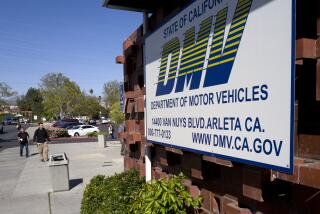Ways to help drivers pass the DMV test
A lot of people don’t like to read, panic at taking a written test and have never quite understood what all those yellow lines on the road mean.
Those are a lot of the folks you share the highway with in California.
When it’s time to take the California driver’s test for a license renewal, one-third of the drivers flunk the exam given in English. Among aspiring drivers who have never taken the exam before, 50% fail.
People taking the test in Spanish for renewal do even worse, with 80% flunking.
Just when you think the American public is better educated and more capable of handling a complex technological world, your optimism is crushed by the realization that there is a collective breakdown in understanding highway rules and regulations.
Not to worry, however. Help is on the way for the video generation. Both the California Department of Motor Vehicles and a private company run by video producer Charles Powell are producing videos for those who can’t learn from a book and others who just can’t get with the program.
The DMV earlier this year started posting information to YouTube, with videos on how to drive. You can find it at www.youtube.com/californiadmv. The agency also has a MySpace destination at myspace.com/californiadmv.
The videos may help inform drivers about all kinds of potential safety issues, but they are not targeted at helping indi- viduals to pass the written exam. For that, you might want to consider Powell’s 45-minute DVD, “Passing the Written DMV Test.”
Powell, 58, said he has sold 10,000 of the videos and offers to refund the $20 purchase price if the buyer fails.
“The DMV manual is really boring and tedious,” Powell said. “My generation learned by reading, but the current generation learns by watching. Kids entering high school in Los Angeles today have a 50% chance of graduating. That’s abysmal. But it corresponds exactly with who is passing the DMV test.”
Powell said he went to a local clothing store known for preppy attire and hired the most clean-cut kids he could find to appear in the video, paying them $50 for half a day’s work. The video was filmed on the streets in Torrance and narrated by a former public relations man for Southern California Edison.
The test aims to provide basic instruction in traffic law in any state, even though states’ laws differ. You can get more information about the DVD at www.passingthedmvtest.com.
In Sacramento, DMV officials are trying to get a better understanding of the problem of failure rates themselves. Dave DeYoung is the DMV’s research chief. Most states don’t even have a DMV research unit, but of those that do, California’s is probably the best in the nation. In many cases, its behavioral driving studies surpass the federal government’s research at the National Highway Traffic Safety Administration.
DeYoung said the DMV has dropped a lot of the rote memorization questions that used to appear on the test, such as how many feet it takes to stop a car going 50 miles per hour. Some questions are mandated by law: How many days do car owners have to register a car brought into the state? (The answer: 10 days.) But generally, the test is aimed at knowledge of basic traffic rules and safe behavior.
The DMV has also tried to reduce failure rates by changing the test format. In 1999, it reduced the possible answers on the multiple choice format test from four to three. And it lowered the percentage of correct answers needed to pass from 86% to 83%. Why is 83% the right proportion? It’s the DMV’s judgment of what represents a “reasonable degree” of knowledge of highway law, DeYoung said.
Those moves actually may have helped more people to pass. Before 1999, 64% of first-time takers were failing; now it’s 50%. .
The DMV hasn’t studied how California drivers are doing compared with those elsewhere. But a study this year by GMAC Insurance, an underwriter, found in a nationwide survey that California’s drivers ranked 22nd in their ability to pass written driving tests. Idaho drivers did best and New York drivers did worst.
Such measures of driver knowledge still don’t tell us one important thing: Who will drive safely?
“You can know all the rules of the road, but it doesn’t mean you will drive safely,” DeYoung acknowledged.
ralph.vartabedian @latimes.com
More to Read
Sign up for Essential California
The most important California stories and recommendations in your inbox every morning.
You may occasionally receive promotional content from the Los Angeles Times.










